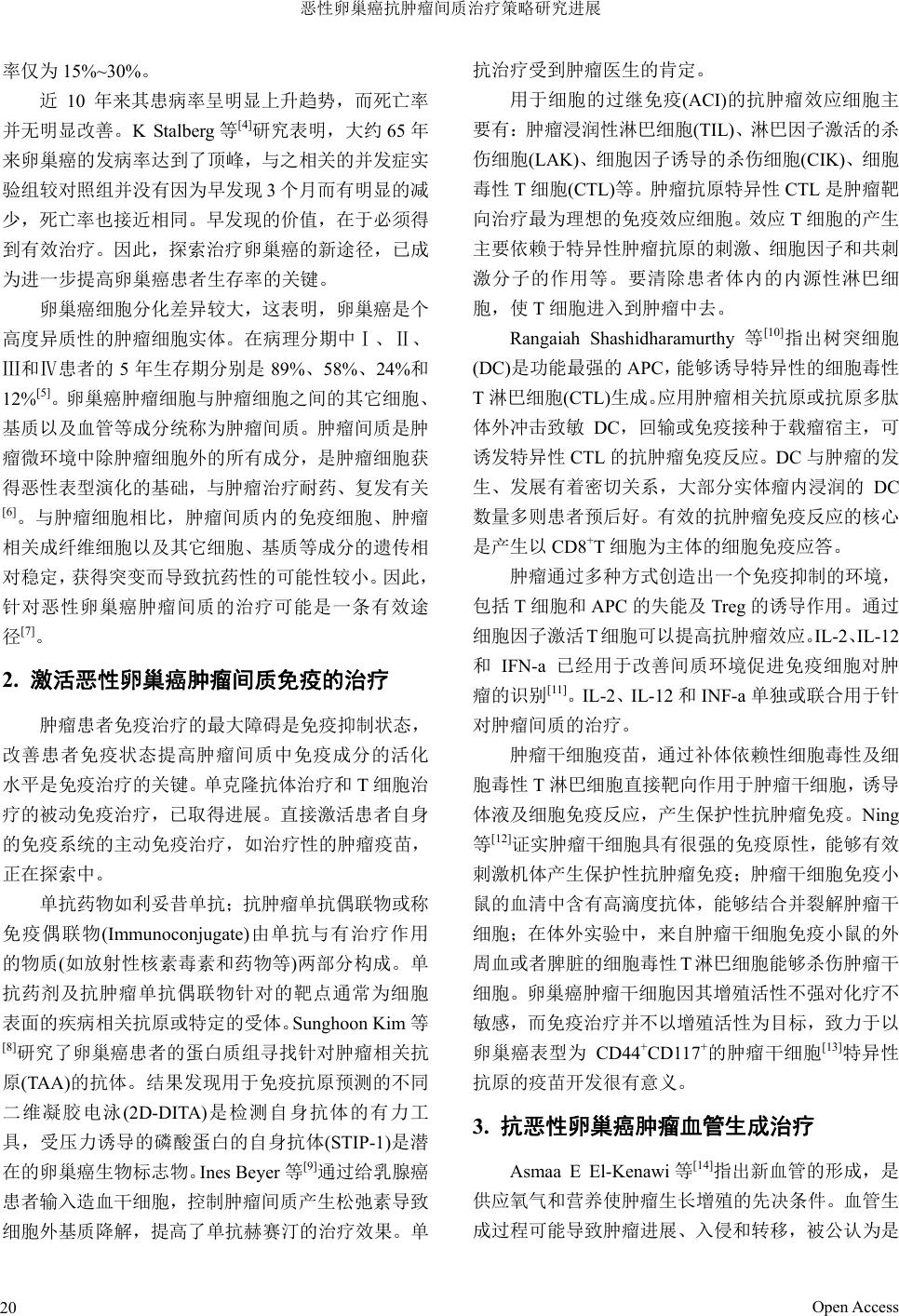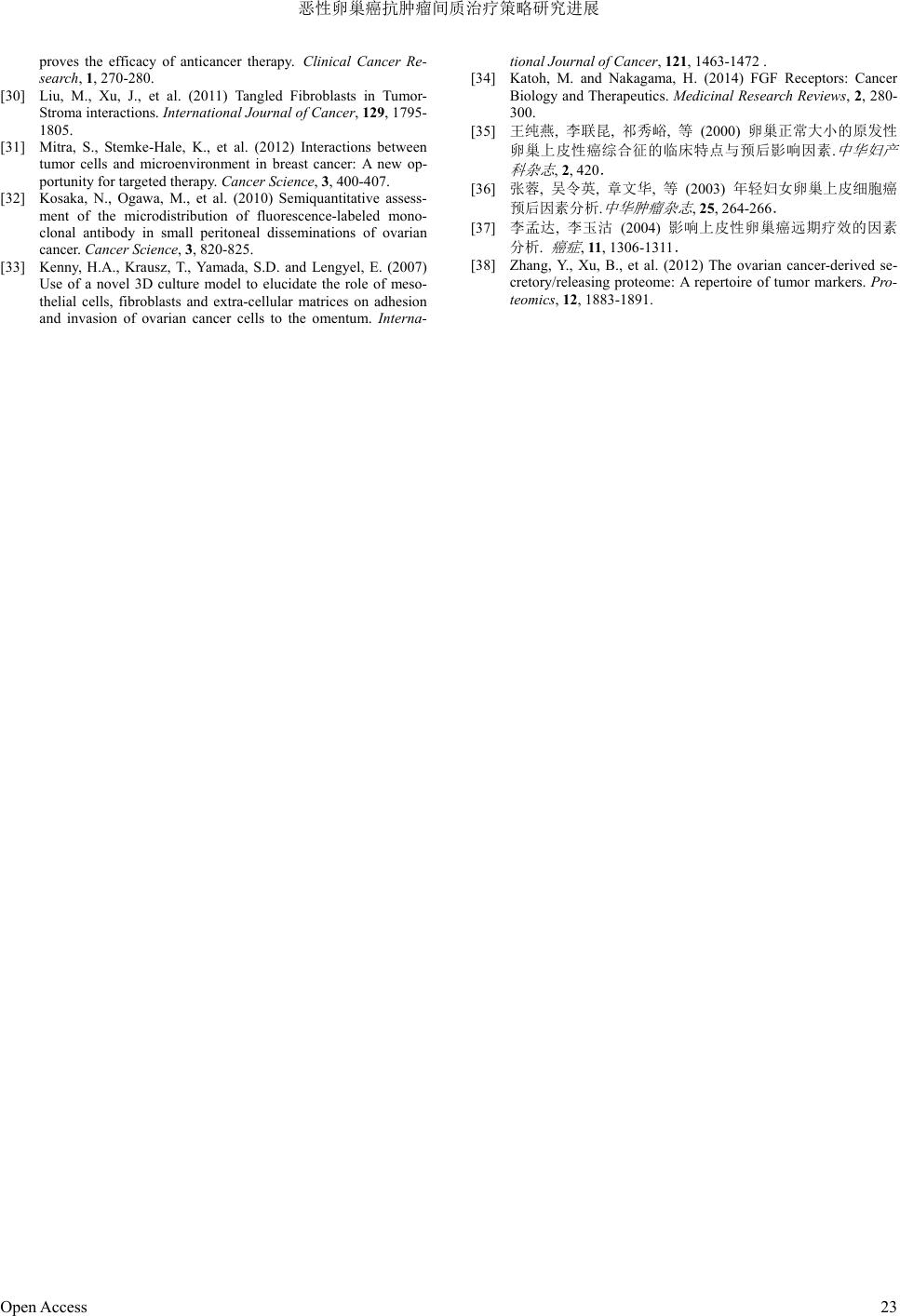 Asian Case Reports in Obstetrics and Gynecology 亚洲妇产科病例研究, 2013, 1, 19-23 http://dx.doi.org/10.12677/acrog.2013.14005 Published Online December 2013 (http://www.hanspub.org/journal/acrog.html) Open Access 19 The Progress of Antitumor Interstitial Treatment Strategy of Malignant Ovarian Cancer* Zhenchao Guo, Tianzhu Zhang#, Ning Gu School of Biological Science and Medical Engineering, Southeast University, Jiangsu Key Laboratory of Biological Materials and Devices, Nanjing Email: guozhenchao@126.com, #zhangtianzhulq@sina.com Received: Nov. 1st, 2013; revised: Nov. 28th, 2013; accepted: Dec. 4th, 2013 Copyright © 2013 Zhenchao Guo et al. This is an open access article distributed under the Creative Commons Attribution License, which permits unrestricted use, distribution, and reproduction in any medium, provided the original work is properly cited. In accordance of the Creative Commons Attribution License all Copyrights © 2013 are reserved for Hans and the owner of the intellectual property Zhenchao Guo et al. All Copyright © 2013 are guarded by law and by Hans as a guardian. Abstract: More than 80% of the patients with ovarian cancer chemotherapy relapse due to drug resistance, which makes the highest ovarian cancer mortality rates among the gynecologic malignancies. Compared with the highly het- erogeneous tumor cell differentiation, tumor stroma cells have genetic stability, and it is unlikely to produce acquired mutations and lead to drug resistance. In view of the treatment strategies for tumor interstitium, ovarian cancer is re- viewed in this paper. At the same time, we pointed out the direction for reducing toxicity, preventing the cancer recur- rence and metastasis, improving the survival rate in the treatment of gynecologic malignancies. Keywords: Ovarian Cancer; Chemotherapy Resistance; Tumor Interstitium; Survival Rate 恶性卵巢癌抗肿瘤间质治疗策略研究进展* 郭振超,张天柱#,顾 宁 东南大学生物科学与医学工程学院,江苏省生物材料与器件重点实验室,南京 Email: guozhenchao@126.com, #zhangtianzhulq@sina.com 收稿日期:2013 年11月1日;修回日期:2013 年11月28日;录用日期:2013年12 月4日 摘 要:超过 80%的卵巢癌患者对化疗药物出现耐药性而复发,使得卵巢癌死亡率居妇科恶性肿瘤之首。与肿 瘤细胞分化高度异质性相比,肿瘤间质细胞遗传性稳定,不大可能产生获得性突变而导致抗药性。本文综述了 卵巢癌针对肿瘤间质的治疗策略,为恶性妇科肿瘤治疗降低毒副作用、防止复发和转移,进一步提高生存率指 明了方向。 关键词:卵巢癌;化疗耐药;肿瘤间质;生存率 1. 引言 卵巢癌是女性生殖系统常见的三大恶性肿瘤之 一,死亡率居妇科恶性肿瘤之首,严重威胁妇女的生 命和健康[1]。因为发病比较隐蔽,许多卵巢癌被诊断 时己是晚期,导致病人生存率下降。目前卵巢癌的常 规治疗主要包括肿瘤细胞减灭术、紫杉醇类和铂类的 联合化疗等[2]。虽然在开始化疗时,这些药物对超过 80%的病人有效,但最终还是因为癌细胞对化疗药物 出现耐药性而复发[3],使得卵巢癌患者总的五年生存 *基金项目:国家重大科学研究计划项目(No.2011CB933503);教育 部新世纪优秀人才支持计划(NCET-09-0298);苏州应用基础研究项 目(SYJ201003);国家重大科学仪器专项(2011YQ03013403)。 #通讯作者。  恶性卵巢癌抗肿瘤间质治疗策略研究进展 Open Access 20 率仅为 15%~30%。 近10 年来其患病率呈明显上升趋势,而死亡率 并无明显改善。K Stalberg等[4]研究表明,大约65 年 来卵巢癌的发病率达到了顶峰,与之相关的并发症实 验组较对照组并没有因为早发现 3个月而有明显的减 少,死亡率也接近相同。早发现的价值,在于必须得 到有效治疗。因此,探索治疗卵巢癌的新途径,已成 为进一步提高卵巢癌患者生存率的关键。 卵巢癌细胞分化差异较大,这表明,卵巢癌是个 高度异质性的肿瘤细胞实体。在病理分期中Ⅰ、Ⅱ、 Ⅲ和Ⅳ患者的 5年生存期分别是 89%、58%、24%和 12%[5]。卵巢癌肿瘤细胞与肿瘤细胞之间的其它细胞、 基质以及血管等成分统称为肿瘤间质。肿瘤间质是肿 瘤微环境中除肿瘤细胞外的所有成分,是肿瘤细胞获 得恶性表型演化的基础,与肿瘤治疗耐药、复发有关 [6]。与肿瘤细胞相比,肿瘤间质内的免疫细胞、肿瘤 相关成纤维细胞以及其它细胞、基质等成分的遗传相 对稳定,获得突变而导致抗药性的可能性较小。因此, 针对恶性卵巢癌肿瘤间质的治疗可能是一条有效途 径[7]。 2. 激活恶性卵巢癌肿瘤间质免疫的治疗 肿瘤患者免疫治疗的最大障碍是免疫抑制状态, 改善患者免疫状态提高肿瘤间质中免疫成分的活化 水平是免疫治疗的关键。单克隆抗体治疗和 T细胞治 疗的被动免疫治疗,已取得进展。直接激活患者自身 的免疫系统的主动免疫治疗,如治疗性的肿瘤疫苗, 正在探索中。 单抗药物如利妥昔单抗;抗肿瘤单抗偶联物或称 免疫偶联物(Immunoconjugate)由单抗与有治疗作用 的物质(如放射性核素毒素和药物等)两部分构成。单 抗药剂及抗肿瘤单抗偶联物针对的靶点通常为细胞 表面的疾病相关抗原或特定的受体。Sunghoon Kim 等 [8]研究了卵巢癌患者的蛋白质组寻找针对肿瘤相关抗 原(TAA)的抗体。结果发现用于免疫抗原预测的不同 二维凝胶电泳(2D-D ITA)是检测自身抗体的有力工 具,受压力诱导的磷酸蛋白的自身抗体(STIP-1)是潜 在的卵巢癌生物标志物。Ines Beyer 等[9]通过给乳腺癌 患者输入造血干细胞,控制肿瘤间质产生松弛素导致 细胞外基质降解,提高了单抗赫赛汀的治疗效果。单 抗治疗受到肿瘤医生的肯定。 用于细胞的过继免疫(ACI)的抗肿瘤效应细胞主 要有:肿瘤浸润性淋巴细胞(TIL)、淋巴因子激活的杀 伤细胞(LAK)、细胞因子诱导的杀伤细胞(CIK)、细胞 毒性 T细胞(CTL)等。肿瘤抗原特异性 CTL 是肿瘤靶 向治疗最为理想的免疫效应细胞。效应T细胞的产生 主要依赖于特异性肿瘤抗原的刺激、细胞因子和共刺 激分子的作用等。要清除患者体内的内源性淋巴细 胞,使 T细胞进入到肿瘤中去。 Rangaiah Shashidharamurthy 等[10]指出树突细胞 (DC)是功能最强的APC,能够诱导特异性的细胞毒性 T淋巴细胞(CTL)生成。应用肿瘤相关抗原或抗原多肽 体外冲击致敏 DC,回输或免疫接种于载瘤宿主,可 诱发特异性 CTL的抗肿瘤免疫反应。DC与肿瘤的发 生、发展有着密切关系,大部分实体瘤内浸润的 DC 数量多则患者预后好。有效的抗肿瘤免疫反应的核心 是产生以 CD8+T细胞为主体的细胞免疫应答。 肿瘤通过多种方式创造出一个免疫抑制的环境, 包括 T细胞和 APC的失能及Treg 的诱导作用。通过 细胞因子激活 T细胞可以提高抗肿瘤效应。IL-2、IL-12 和 IFN-a已经用于改善间质环境促进免疫细胞对肿 瘤的识别[11]。IL-2、IL-12和INF-a 单独或联合用于针 对肿瘤间质的治疗。 肿瘤干细胞疫苗,通过补体依赖性细胞毒性及细 胞毒性 T淋巴细胞直接靶向作用于肿瘤干细胞,诱导 体液及细胞免疫反应,产生保护性抗肿瘤免疫。Ning 等[12]证实肿瘤干细胞具有很强的免疫原性,能够有效 刺激机体产生保护性抗肿瘤免疫;肿瘤干细胞免疫小 鼠的血清中含有高滴度抗体,能够结合并裂解肿瘤干 细胞;在体外实验中,来自肿瘤干细胞免疫小鼠的外 周血或者脾脏的细胞毒性T淋巴细胞能够杀伤肿瘤干 细胞。卵巢癌肿瘤干细胞因其增殖活性不强对化疗不 敏感,而免疫治疗并不以增殖活性为目标,致力于以 卵巢癌表型为 CD44+CD117+的肿瘤干细胞[13]特异性 抗原的疫苗开发很有意义。 3. 抗恶性卵巢癌肿瘤血管生成治疗 Asmaa E El-Kenawi等[14]指出新血管的形成,是 供应氧气和营养使肿瘤生长增殖的先决条件。血管生 成过程可能导致肿瘤进展、入侵和转移,被公认为是  恶性卵巢癌抗肿瘤间质治疗策略研究进展 Open Access 21 肿瘤预后的一项指标。因此,肿瘤血管生成与否已成 为提高临床治疗的相关性评价的重要标准[15]。血管生 成抑制剂分为直接抑制剂,抑制目标血管内皮细胞增 长;或间接抑制剂,防止表达或阻碍血管生成[16]。后 者类扩展了对癌基因包括有针对性的治疗、传统的化 疗药物和针对微环境的其他肿瘤细胞。血管生成抑制 剂可作为单药治疗或使用结合其他抗癌药物。血管生 成抑制剂具有广泛的治疗作用目标,对各种肿瘤具有 普适性[17]。 肿瘤的生长与肿瘤血管的形成密不可分。抗肿瘤 血管治疗的目的就是阻断血管生成信号。这可以通过 抑制血管生成因子(VEGF)或受体来实现[18]。抗VEGF 的贝伐珠单克隆抗体是目前最为成熟的抗血管生成 药物。贝伐珠单抗单独使用可以显著抑制多种肿瘤的 生长[19]。2004 年,贝伐珠单抗被美国FDA 批准为治 疗肿瘤的第一个抗血管药物。抗血管生成药物也可以 与化疗协同使用提高疗效,如伊立替康与5-氟尿嘧 啶。 抗表皮生长因子受体的西妥昔单抗和帕尼单抗 及小分子酪氨酸激酶抑制剂TIKs也有抗血管生成的 效果。 干扰素 α是一个免疫调节的细胞因子,它可以下 调前血管源性分子,因此也被用于抗肿瘤血管治疗。 干扰素 α具有抗病毒、抗肿瘤和免疫调节作用,有增 强免疫对病毒感染细胞的免疫杀伤活性。干扰素 α还 能增强巨噬细胞的吞噬功能和细胞毒活性[20]。 4. 抗恶性卵巢癌肿细胞外基质降解的治疗 G S Wong等[21]指出胞外基质蛋白质被归类为非 结构性基质蛋白家族,调节各种各样的的生物学过 程。这些蛋白质表达动态及其细胞功能高度依赖于来 自局部环境的变化。最近的研究表明 ECM 蛋白质在 肿瘤微环境中发挥关键作用,诱导肿瘤细胞或肿瘤基 质组建,胞外基质蛋白质启动下游信号事件,导致扩 散、入侵、基质改造和在其他器官传播发生癌前转移。 ECM 蛋白质在微环境中扮演不同的角色影响肿瘤进 展,是肿瘤微环境的治疗目标[22]。 肿瘤细胞首先从原发部位脱落,黏附、降解和侵 入ECM[23],而后侵入血管或淋巴管壁,在血 管和淋 巴循环内转运,然后,肿瘤细胞的外渗又需要对基底 膜和 ECM进行降解[24]。在这些基质结构改变中,ECM 的降解是至关重要的[25],其中 MMPs 和尿激酶纤溶酶 原激活物(uPA)在ECM 的降解中起重要作用[26]。 多种抑制 MMPs 表达和功能的手段已在Ⅲ期临 床实验。如氧肟酸盐、二磷酸盐、四环素类和组织金 属蛋白酶抑制剂(TIMPs)可阻断 MMPs 的活性。体外 和动物实验证明了MMPs 合成抑制剂的有效性。 uPA 将纤溶酶原转化为纤溶酶,而后可以直接或 间接活化其它蛋白酶来降解某些 ECM 蛋白,如胶原 Ⅳ,层黏连蛋白和纤维结合素。uPA 的受体 uPAR (CD87)和抑制剂、以及纤溶酶原活化因子抑制剂 1(PA1)[27],参与调解正常和病理下的细胞迁移、组织 降解和血管发生。如中和抗体,可溶性受体,催化失 活的 uPA 片段和合成肽类/拟肽类药物,siRNA 和DNA 酶[28]。研究发现,选择性靶向抑制uPA/uPAR 的治疗 未伴有严重的副作用。最近,一种uPA衍生的多肽 A6,单独或联合其它治疗时,在动物模型中减少了肿 瘤的生长、转移、血管发生[29]。在卵巢癌患者中进行 Ⅰ期试验,证明其安全性,并显示出一些疗效。 5. 抗恶性卵巢癌肿瘤相关成纤维细胞的 治疗 Min Liu等[30]指出肿瘤间质发生过程中起着重要 的作用,因为它调节发展、分化和增殖的上皮细胞。 肿瘤间质包细胞外基质(ECM)和细胞成分如成纤维细 胞、免疫和炎症细胞、血管等。成纤维细胞,负责合成、 沉积、ECM 重塑和调节上皮分化[31]。在临床肿瘤治 疗中人们发现癌细胞的基因突变伴有恶性晚期肿瘤 形成,却无视结构异常并且复杂的基质性质的改变 [32]。纤维或结缔组织“粘连形成”通常会出现癌症。 肿瘤间质的主要成分肿瘤相关成纤维细胞(CAFs) 存在于肿瘤细胞邻近,促进肿瘤的发生和发展。CAFs 能够将机体中的免疫细胞招募至肿瘤部位促进肿瘤 生长[33]。癌细胞可诱导正常的皮肤成纤维细胞表达促 炎性因子。近年来,CAFs作为一种肿瘤靶向治疗的 靶标备受关注[34]。 成纤维细胞活化蛋白 α(FAPα)是特异性表达于 CAF表面的一种丝氨酸蛋白酶,参与 ECM的降解, 在肿瘤基质的降解和重建中发挥着重要作用。成纤维 细胞活化蛋白 α过表达与对外外源性生长因子的依赖  恶性卵巢癌抗肿瘤间质治疗策略研究进展 Open Access 22 性降低,肿瘤生长、侵袭,血管形成和转移的增强相 关。 FAPα单克隆抗体 F19(尼妥珠单抗),是我国第一 个用于治疗恶性肿瘤的功能性单抗药物。单克隆抗体 是针对特异抗原产生的特异纯化抗体,它具有高度专 一性,能够特异性针对肿瘤细胞进行靶向治疗,从分 子水平逆转肿瘤细胞的恶性生物学行为,因而有“生 物导弹”之称。该类药物具有靶向性强、特异性高和 毒副作用低等特点,并能增强放、化疗的治疗效果, 代表着肿瘤治疗领域的最新发展方向。 6. 结语 妇女一生罹患卵巢癌的风险为1/70。卵巢癌的死 亡率之所以高于其他妇科肿瘤,在于 75%的患者就诊 时已属晚期[35]。近30 年,虽然采用了新型化疗方案、 有力的支持治疗以及彻底的肿瘤细胞减灭术,患者的 平均生存时间有所提高,但晚期患者的绝对治愈率却 没有明显提高。肿瘤分期与其预后密切相关[36]。防止 癌前病变将会是人类控制恶性肿瘤的一个重要战略 措施[37]。同时对于已是晚期且对化疗耐药的低分化患 者,针对恶性卵巢癌肿瘤间质遗传稳定的特点进行有 选择地靶向治疗[38],降低药物毒副作用,防止复发和 转移,进一步提高生存率具有重要意义。 参考文献 (References) [1] 张桂荣, 翟云起, 杜少敏, 等 (2003) 卵巢上皮癌治疗及预后 影响因素研究. 肿瘤学杂志 , 2, 68-70. [2] Teng, P.-N., Wang, G., et al. (2014) Identification of candidate circulating cisplatin-resistant biomarkers from epithelial ovarian carcinoma cell secretomes. British Journal of Cancer, 110, 123- 132. [3] 减荣余, 张志毅, 李子庭, 等 (200l) 晚期上皮性卵巢癌的预 后影响因素. 复旦学报 ( 医学科学版 ), 1, 46-47. [4] Stalberg, K., Svensson, T., et al. (2012) Evaluation of prevalent and incident ovarian cancer co-morbidity. British Journal of Cancer, 106, 1860-1865. [5] 何义富, 孙玉蓓, 陈健, 等 (2009) 腹腔内应用重组人血管内 皮抑制素联合氟尿嘧啶治疗恶性腹水的初步探讨. 临床肿瘤 学杂志 , 3, 252. [6] Marcucci, F., Bellone, M., et al. (2013) Pushing tumor cells towards a malignant phenotype: Stimuli from the microenvi- ronment, intercellular communications and alternative roads. In- ternational Journal of Cancer, 1, 1-12. [7] Junttila, M.R., de Sauvage, F.J. (2013) Influence of tumour micro-environment heterogeneity on therapeutic response. Na- ture, 19, 346-354. [8] Kim, S., Cho, H.B., et al. (2010) Autoantibodies against Stress- Induced Phosphoprotein-1 as a Novel Biomarker Candidate for Ovarian Cancer. Genes, Chromosomes & Cancer, 49, 585-595. [9] Beyer, I., Li, Z., et al. (2011) Controlled Extracellular Matrix Degradation in Breast Cancer Tumors Improves Therapy by Trastuzumab. Molecul ar T he ra py , 3, 479-489. [10] Shashidharamurthy, R., Bozeman, E.N., et al. (2012) Immuno- therapeutic Strategies for Cancer Treatment: A Novel Protein- Transfer Approach for Cancer Vaccine Development. Medicinal Research Reviews, 6, 1197-1219. [11] Bukovsky, A. (2011) Immune Maintenance of Self in Mor- phostasis of Distinct Tissues, Tumour Growth and Regenerative Medicine. Scandinavian Journal of Immunology, 73, 159-189. [12] Ning, N., Pan, Q., Zheng, F., et al. (2012) Cancer stemcell vac- cination confers significant antitumor immunity. Cancer Re- search, 7, 18-53. [13] Luo, L., Zeng, J., Liang, B., et al. (2011) Ovarian cancer cells with the CD117 phenotype are highly tumorigenic and are re- lated to chemotherapy outcome. Experimental and Molecular Pathology, 2, 596-602. [14] El-Kenawi, A.E. and El-Remessy, A.B. (2013) Angiogenesis inhibitors in cancer therapy: mechanistic perspective on classi- fication and treatment rationales. British Journal of Pharmacol- ogy, 170, 712-729. [15] Buergy, D., Wenz, F., et al. (2012) Tumor-platelet interaction in solid tumors. International Journal of Cancer, 130, 2747-2760. [16] Koyanagi, T. and Suzuki, Y. (2013) In Vivo delivery of siRNA targeting vasohibin-2 decreases tumor angiogenesis and sup- presses tumor growth in ovarian cancer. Cancer Science, 12, 1705-1710. [17] Wu, F.T.H., Stefanini, M.O., et al. (2010) A systems biology perspective on sVEGFR1: its biological function, pathogenic role and therapeutic use. Journal of Cellular and Molecular Medicine, 3, 528-552. [18] McKeage, M.J. and Baguley, B.C. (2010) Disrupting Established Tumor Blood Vessels. Cancer, 15, 1859-1866. [19] Khalid, B., et al. (1998) Absence of Host Plasminogen Activator Inhibitor 1 Prevents Cancer Invasion and Vascularization. Na- ture Medicine, 8, 923-928. [20] Hanna, E., Quick, J. and Libutti, S.K. (2009) The tuour micro- enviroment: A novel target for cancer therapy. Oral Diseases, 1, 8-17. [21] Wong, G.S. and Rustgi, A.K. (2013) Matricellular proteins: priming the tumour microenvironment for cancer development and metastasis. British Journal of Cancer, 108, 755-761. [22] Akerman, S., Fisher, M., et al. (2013) Influence of soluble or matrix-bound isoforms of vascular endothelial growth factor-A on tumor response to vascular-targeted strategies. International Journal of Cancer, 133, 2563-2576. [23] Provenzano, P.P. and Hingorani, S.R. (2013) Hyaluronan, fluid pressure, and stromal resistance in pancreas cancer. British Jour- nal of Cancer, 108, 1-8. [24] Mueller, M.M. and Fuening, N.E. (2004) Friend or foes-bipolar effect of the tumor stroma in cancer. Nature Reviews Cancer, 11, 839-849. [25] Anton, K. and Glod, J. (2009) Targeting the tumor stroma in cancer therapy. Current Pharmaceutical Biotechnology, 2, 185- 191. [26] Mani, T., Wang, F., et al. (2013) Small-molecule inhibition of the uPAR, uPA interaction: Synthesis, biochemical, cellular, in vivo pharmacokinetics and efficacy studies in breast cancer metasta- sis. Bioorganic & Medicinal Chemistry, Bioorganic & Medicinal Chemistry, 21, 2145-2155. [27] Nordengren, J., Pilka, R., Noskova, V., et al. (2004) Differential localization and expression of urokinase plasminogen activator (uPA), its receptor (uPAR), and its inhibitor (PAI-1) mRNA and protein in endometrial tissue during the menstrual cycle. Mo- lecular Human Reproduction, 9, 655-663. [28] Hofmeister, V., Schrama, D. and Becker, J.C. (2008)Anti-cancer therapy targeting the tumor stroma. Cancer Immunology, Im- munotherapy, 1, 1-17. [29] Blansfield, J.A., Caragaciam, D., Alexander, H.R., et al. (2008) Combining agents that target the tumor microenvironment im-  恶性卵巢癌抗肿瘤间质治疗策略研究进展 Open Access 23 proves the efficacy of anticancer therapy. Clinical Cancer Re- search, 1, 270-280. [30] Liu, M., Xu, J., et al. (2011) Tangled Fibroblasts in Tumor- Stroma interactions. International Journal of Cancer, 129, 1795- 1805. [31] Mitra, S., Stemke-Hale, K., et al. (2012) Interactions between tumor cells and microenvironment in breast cancer: A new op- portunity for targeted therapy. Cancer Science, 3, 400-407. [32] Kosaka, N., Ogawa, M., et al. (2010) Semiquantitative assess- ment of the microdistribution of fluorescence-labeled mono- clonal antibody in small peritoneal disseminations of ovarian cancer. Cancer Science, 3, 820-825. [33] Kenny, H.A., Krausz, T., Yamada, S.D. and Lengyel, E. (2007) Use of a novel 3D culture model to elucidate the role of meso- thelial cells, fibroblasts and extra-cellular matrices on adhesion and invasion of ovarian cancer cells to the omentum. Interna- tional Journal of Cancer, 121, 1463-1472 . [34] Katoh, M. and Nakagama, H. (2014) FGF Receptors: Cancer Biology and Therapeutics. Medicinal Research Reviews, 2, 280- 300. [35] 王纯燕, 李联昆, 祁秀峪, 等 (2000) 卵巢正常大小的原发性 卵巢上皮性癌综合征的临床特点与预后影响因素. 中华妇产 科杂志 , 2, 420. [36] 张蓉, 吴令英, 章文华, 等 (2003) 年轻妇女卵巢上皮细胞癌 预后因素分析. 中华肿瘤杂志 , 25, 264-266. [37] 李孟达, 李玉沽 (2004) 影响上皮性卵巢癌远期疗效的因素 分析. 癌症 , 11, 1306-1311. [38] Zhang, Y., Xu, B., et al. (2012) The ovarian cancer-derived se- cretory/releasing proteome: A repertoire of tumor markers. Pro- teomics, 12, 1883-1891. |